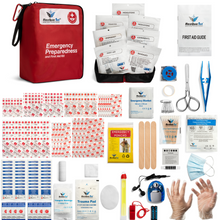When the unexpected strikes, every second counts. A bug out backpack can be the difference between avoiding a disaster and scrambling around for the equipment you need. A bit of preparation when times are good can save you precious moments.
A go bag (often called a bug out bag or a 72 hour bag) contains everything you need to stay safe and well in a disaster. We're talking food, water, clothes, safety supplies, medication, copies of your most important documents, and anything else you might need if you have to leave home in a hurry. A great rule of thumb is to pack everything necessary to survive for 72 hours - enough time for the disaster to subside and help to come your way.
So What do I Put in This Thing?
A bug out bag can be as simple or as complex as you want it to be, but we recommend having a few basic areas fully covered. But first, a note on the bag itself. It's tempting to buy a big bag and fill it with everything you can think of, but an over-packed bag isn't necessarily a helpful bag. Insead, assemble everything you plan to load into your bag, then choose the best bug out bag to fit.
You'll need to have the following areas covered to have a reliable bag on your hands:
-
Food: Again, the rule of thumb is to have 72 hours worth of food in your tactical go bag. Dehydrated meals (MREs) are a great choice here. They're lightweight, easy to heat, and keep a long time. Protein bars are also a long lasting, calorie dense choice for bug out bag food. Finally, don't neglect cooking supplies. A dehydrated dinner on its own won't do you much good if you need boiling water to reconstitute it. A lightweight portable stove, stove fuel, and a cooking pot are all valuable assets.
-
Water: At a minimum you need 1 liter of water per person per day in your survival bug out bag. Again, that's at a minimum. A water bottle and purification tablets or a water filtration tool (like a lifestraw) can help make natural water sources potable, but there's really no substitute to having clean water on hand when you need it.
- Clothing: Pack two full sets of clothes per person in your bug out bag. The last thing you want is to be stuck in something cold and wet when you're in the elements. Your exact clothing needs will vary based on your location and typical weather, but lightweight pants and shirts, two pairs of underwear, a medium weight fleece, and a weather resistant poncho are all a must. And whatever you do, don't forget extra wool socks - dry feet are healthy feet.
-
First Aid: If you're bugging out, you're probably in a bad situation. An injury will make it worse. Add a full complement of first aid supplies to your bug out list and you'll be able to deal with any minor to moderate injury you may encounter. Bandages, antibiotic ointment, scissors, gauze, and medical tape are all must-haves. If you're not confident about what you should or shouldn't include, a pre-made kit will make sure all your bases are covered. This hardshell kit has everything your bug out bag needs in a sturdy container - perfect for when the unexpected strikes.
-
Safety: A few key items can make a dangerous situation manageable. A flashlight with extra batteries, a radio, an emergency blanket, a bug out tent, and a whistle are indispensable when it comes to staying safe in unwelcoming terrain.
- Medication and Documents: Round out your bag with copies of important documents (such as your driver's license, passport, and birth certificate) and a several day supply of any prescription medications you rely on.
Go Pro
There's a lot that goes into building the best bug out backpack. For some, constructing and maintaining a bug out bag is a hobby all on its own. But for many of us it's the function that's important. Don't be afraid to take advantage of professionally assembled kits. You'll be sure to have everything you need without the guesswork of pulling it all together by yourself.
However you choose to make your emergency bag, here's hoping you'll never have to use it. Stay safe and be prepared.









